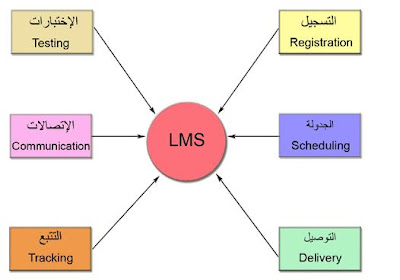إدارة المحتوى التعليمي LCMS

يعتبر نظام إدارة المحتوى التعليمي LCMS الجيل المطوَّر من نظام إدارة التعلم LMS ولكنه يزيد عليه في أنه يتيح للعديد من المؤلفين المشاركة في إنشاء وتخزين واستخدام وإعادة استخدام وحدات المحتوى التعليمي . ويمكن اعتبار نظام إدارة المحتوى التعليمي ضمن هيكلة التعليم المساند بالانترنت Web-based learning . لذلك عندما يطلق تعبير LCMS فإنه مما يقصد به أي برنامج حاسوبي يعمل على تسهيل التعلم بواسطة الحاسوب والانترنت ، وفيها يكون فرعا ضمن عائلة أشمل تعرف بالتعليم الالكتروني . وفي الوقت ذاته فإن نظام إدارة المحتوى التعليمي LCMS هو أحد أنواع أنظمة إدارة المحتوىCMS) Content Management System ) وهو بدوره عبارة عن تطيبقات متعددة تسهل عمليات تصميم واختبار ونشر المحتوى الالكتروني على صفحات الانترنت .
من هنا نفهم أن نظام إدارة المحتوى التعليمي هو تطبيق حاسوبي حديث مقارنة مع البرامج التي انبثق عنها من جهة ، ومن جهة أخرى أنه جاء مختصا لإدارة أنظمة المحتوى التعليمي فقط .
ونتيجة هذا التداخل في الفهم بين هذه النظم الحاسوبية الثلاثة ( LMS, LCMS , CMS ) وموقعها من منظمة التعليم الالكتروني كان لابد من تقديم المزيد من الفروق حولها .
§ إدرة نظام التعلم Learning Management System (LMS)
An LMS primarily focuses on competencies, learning activities, and the logistics of delivering learning activities. An LMS does not focus on creation, reusability, management, or improvement of content itself
(Raghavan، 2001)
وهو عبارة عن برنامج Software صمم للمساعدة في إدارة ومتابعة وتقيم التدريب والتعليم المستمر وجميع أنشطة التعلم في المنشآت .لذا فهو يعتبر حل استراتيجي للتخطيط والتدريب وإدارة جميع أوجه التعلم في المنشأة بما في ذلك البث الحي online أو القاعات التخيلية virtual classroom أو المقررات الموجهة من قبل المدربين. وهذا سيجعل الأنشطة التعليمية التي كانت منفصلة ومعزولة عن بعضها تصبح تعمل وفق نظام مترابط يسهم في رفع مستوى التدريب. وعلى الجانب الآخر ، فإن LMS لا تركز كثيراً على المحتوى . لا من حيث تكوينه ولا إعادة استخدامه و لا حتى من حيث تطوير المحتوى.
من خصائص نظام إدارة التعلم : LMS
§ Support for blended learning
§ Integration with HR
§ Administration tools
§ Content integration
§ Adherence to standards
§ Assessment capabilities
§ Skills management
من هنا نفهم أن نظام إدارة المحتوى التعليمي هو تطبيق حاسوبي حديث مقارنة مع البرامج التي انبثق عنها من جهة ، ومن جهة أخرى أنه جاء مختصا لإدارة أنظمة المحتوى التعليمي فقط .
ونتيجة هذا التداخل في الفهم بين هذه النظم الحاسوبية الثلاثة ( LMS, LCMS , CMS ) وموقعها من منظمة التعليم الالكتروني كان لابد من تقديم المزيد من الفروق حولها .
§ إدرة نظام التعلم Learning Management System (LMS)
An LMS primarily focuses on competencies, learning activities, and the logistics of delivering learning activities. An LMS does not focus on creation, reusability, management, or improvement of content itself
(Raghavan، 2001)
وهو عبارة عن برنامج Software صمم للمساعدة في إدارة ومتابعة وتقيم التدريب والتعليم المستمر وجميع أنشطة التعلم في المنشآت .لذا فهو يعتبر حل استراتيجي للتخطيط والتدريب وإدارة جميع أوجه التعلم في المنشأة بما في ذلك البث الحي online أو القاعات التخيلية virtual classroom أو المقررات الموجهة من قبل المدربين. وهذا سيجعل الأنشطة التعليمية التي كانت منفصلة ومعزولة عن بعضها تصبح تعمل وفق نظام مترابط يسهم في رفع مستوى التدريب. وعلى الجانب الآخر ، فإن LMS لا تركز كثيراً على المحتوى . لا من حيث تكوينه ولا إعادة استخدامه و لا حتى من حيث تطوير المحتوى.
من خصائص نظام إدارة التعلم : LMS
§ Support for blended learning
§ Integration with HR
§ Administration tools
§ Content integration
§ Adherence to standards
§ Assessment capabilities
§ Skills management
§ الدمج بين LMS و LCMS:
إدارة أنظمة التعلم LMS الجيدة توفر البيئة التي تمكن المنظمة من التخطيط توفير المحتوى وإدارة المناشط التعليمية وفق ما يخدم المتدربين . كما أنها تدعم أنظمة التأليف وتدمج بسهولة مع أنظمة إدارة المحتوى LCMS . و LMS تدمج مع LCMS بواسطة خصائص تقنية معايير متفق عليها بحيث تتولى LMS كل المهام المتعلقة بإدارة المحتوى من تخزين المحتوى في المستودع repository وتجميع وفك تجميع المحتوى وإشراك المحتوى داخل خطة تعليمية التقليدية مع متابعة أداء المتعلمين خلال المقرر
Integrating LMSs with LCMSs
A good LMS provides an infrastructure that enables a company to plan, deliver, and manage learning programs in any format it chooses. It will support multiple authoring systems and integrate easily with the leading LCMS systems. In its role as a catalyst for the overall learning environment, an LMS can integrate LCMS learning objects via technical specifications and standards and assume responsibility for all content management, including delivery and tracking, storage in a content repository, assembly and reassembly of content objects, incorporation of content objects into blended curriculums, and tracking learner progress through courses.
The key to integration success is an open, interoperable approach. Currently, leading LMS and LCMS suppliers are launching certification programs that proactively address compatibility issues and ensure interoperability between their products. While time-consuming and expensive for the suppliers, certification programs shield customers from integration hassles or having to settle for patchwork solutions from suppliers who try to do it all. The certification approach gives buyers the freedom to choose both the LMS and LCMS that best meets their needs.
Object level management has been around forever and solves a myriad of IT problems, but it’s not a panacea. Indeed, one analyst employs the following metaphor to illustrate the function of an LCMS. Traditional courses are bags of jelly beans, learning objects are the beans inside the bag, and LCMSs are systems that open all the bags, pour the beans into one big jar, and put descriptive tags on each bean so they can be repackaged into new bags on demand.
The question remains: Just because the technology exists to manage your e-learning content at the bean level, will it have a significant impact on productivity? Can you solve the need for just-enough learning other ways? LCMSs aren’t an inexpensive proposition. Before you invest, ask whether the problems they solve are the problems you care about
Leonard Greenberg)2002 )

تعليقات